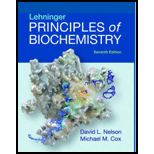
Concept explainers
(a1)
To determine: The point where citric acid cycle is blocked.
Introduction:
The citric acid cycle is an aerobic respiration which produces excess amount of energy. The intermediate products of the citric acid cycle connect the
(a2)
To determine: The reason of accumulation of citrate and depletion of intermediates of other cycles.
Introduction:
The citric acid cycle is an aerobic respiration which produces excess amount of energy. The intermediate products of the citric acid cycle connect the metabolism of proteins, carbohydrates and fats. In the cycle, metabolism of acetyl CoA produces carbon dioxide and water.
(b1)
To determine: The structure of end product of fluoroacetate metabolism.
Introduction:
Metabolism is a chain of
(b2)
To determine: The reason for blockage of citric acid cycle due to the end product.
Introduction:
Metabolism is a chain of chemical reactions to break down the substances in order to generate new substance. In cellular metabolism, fluoroacetate combines with CoA to form fluoroacetyl CoA. It can replace acetyl CoA in the citric acid cycle and reacts with enzyme citrate synthase to produce fluorocitrate.
(b3)
To determine: The way to overcome the inhibition.
Introduction:
Metabolism is a chain of chemical reactions to break down the substances in order to generate new substance. In cellular metabolism, fluoroacetate combines with CoA to form fluoroacetyl CoA. It can replace acetyl CoA in the citric acid cycle and reacts with enzyme citrate synthase to produce fluorocitrate.
(c1)
To determine: The reason for decrement in glucose uptake and glycolysis in the experiment of heart perfusion.
Introduction:
Glycolysis is an aerobic respiration process which takes place to produce large amount of energy. Glycolysis process involves the continuous use of enzymes. Enzymes take part in the conversion of one cycle intermediate into another intermediate.
(c2)
To determine: The reason for accumulation of hexose monophosphate.
Introduction:
Glycolysis is an aerobic respiration process which takes place to produce large amount of energy. Glycolysis process involves the continuous use of enzymes. Enzymes take part in the conversion of one cycle intermediate into another intermediate. Any kind of inhibition in the enzymatic activity can cause decrement in the glycolysis cycle.
(d)
To describe: The reason for fatal property of fluoroacetate
Introduction:
Fluoroacetate is used as a rodenticide. It affects mammals and birds. The property of fluoroacetate is poisonous for cells because it is analog to citrate and is an inhibitor of citrate synthase enzyme. Inhibition of the enzymatic activity stops the cycle to proceed further and the cells lose their metabolic activity.
Want to see the full answer?
Check out a sample textbook solution
Chapter 16 Solutions
Lehninger Principles of Biochemistry
- Which type of enzyme catalyses the following reaction? oxidoreductase, transferase, hydrolase, lyase, isomerase, or ligase.arrow_forward+NH+ CO₂ +P H₂N + ATP H₂N NH₂ +ADParrow_forwardWhich type of enzyme catalyses the following reaction? oxidoreductase, transferase, hydrolase, lyase, isomerase, or ligase.arrow_forward
- Which features of the curves in Figure 30-2 indicates that the enzyme is not consumed in the overall reaction? ES is lower in energy that E + S and EP is lower in energy than E + P. What does this tell you about the stability of ES versus E + S and EP versus E + P.arrow_forwardLooking at the figure 30-5 what intermolecular forces are present between the substrate and the enzyme and the substrate and cofactors.arrow_forwardprovide short answers to the followings Urgent!arrow_forward
- Pyruvate is accepted into the TCA cycle by a “feeder” reaction using the pyruvatedehydrogenase complex, resulting in acetyl-CoA and CO2. Provide a full mechanismfor this reaction utilizing the TPP cofactor. Include the roles of all cofactors.arrow_forwardB- Vitamins are converted readily into important metabolic cofactors. Deficiency inany one of them has serious side effects. a. The disease beriberi results from a vitamin B 1 (Thiamine) deficiency and ischaracterized by cardiac and neurological symptoms. One key diagnostic forthis disease is an increased level of pyruvate and α-ketoglutarate in thebloodstream. How does this vitamin deficiency lead to increased serumlevels of these factors? b. What would you expect the effect on the TCA intermediates for a patientsuffering from vitamin B 5 deficiency? c. What would you expect the effect on the TCA intermediates for a patientsuffering from vitamin B 2 /B 3 deficiency?arrow_forwardDraw the Krebs Cycle and show the entry points for the amino acids Alanine,Glutamic Acid, Asparagine, and Valine into the Krebs Cycle - (Draw the Mechanism). How many rounds of Krebs will be required to waste all Carbons of Glutamic Acidas CO2?arrow_forward
 BiochemistryBiochemistryISBN:9781319114671Author:Lubert Stryer, Jeremy M. Berg, John L. Tymoczko, Gregory J. Gatto Jr.Publisher:W. H. Freeman
BiochemistryBiochemistryISBN:9781319114671Author:Lubert Stryer, Jeremy M. Berg, John L. Tymoczko, Gregory J. Gatto Jr.Publisher:W. H. Freeman Lehninger Principles of BiochemistryBiochemistryISBN:9781464126116Author:David L. Nelson, Michael M. CoxPublisher:W. H. Freeman
Lehninger Principles of BiochemistryBiochemistryISBN:9781464126116Author:David L. Nelson, Michael M. CoxPublisher:W. H. Freeman Fundamentals of Biochemistry: Life at the Molecul...BiochemistryISBN:9781118918401Author:Donald Voet, Judith G. Voet, Charlotte W. PrattPublisher:WILEY
Fundamentals of Biochemistry: Life at the Molecul...BiochemistryISBN:9781118918401Author:Donald Voet, Judith G. Voet, Charlotte W. PrattPublisher:WILEY BiochemistryBiochemistryISBN:9781305961135Author:Mary K. Campbell, Shawn O. Farrell, Owen M. McDougalPublisher:Cengage Learning
BiochemistryBiochemistryISBN:9781305961135Author:Mary K. Campbell, Shawn O. Farrell, Owen M. McDougalPublisher:Cengage Learning BiochemistryBiochemistryISBN:9781305577206Author:Reginald H. Garrett, Charles M. GrishamPublisher:Cengage Learning
BiochemistryBiochemistryISBN:9781305577206Author:Reginald H. Garrett, Charles M. GrishamPublisher:Cengage Learning Fundamentals of General, Organic, and Biological ...BiochemistryISBN:9780134015187Author:John E. McMurry, David S. Ballantine, Carl A. Hoeger, Virginia E. PetersonPublisher:PEARSON
Fundamentals of General, Organic, and Biological ...BiochemistryISBN:9780134015187Author:John E. McMurry, David S. Ballantine, Carl A. Hoeger, Virginia E. PetersonPublisher:PEARSON





